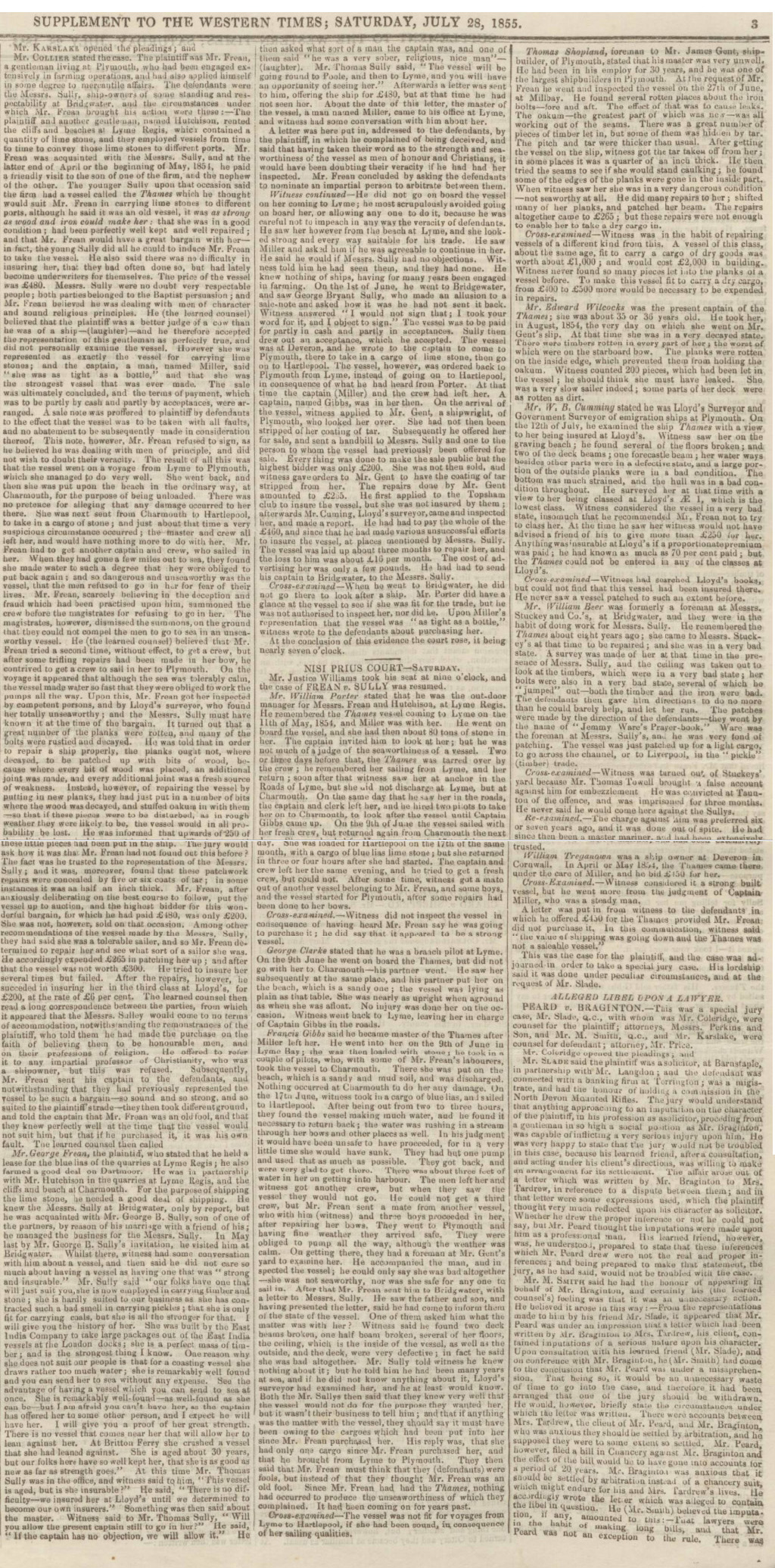
Charmouth Heritage Centre
The entrepeneur, George Frean main focus must have been the setting up of a Cement Works near the existing Lime Kilns by the mouth of the River Char and the sea. His sister, Anna Frean had married Michael Morcom, described as a merchant at Plymouth in 1836. They were to have ten children. One of whom - George Frean Morcom was to later reside in Los Angles and become world famous as an Ornithologist. But in 1851, the family are living at St Agnes in Cornwall and Michael is described as a Mine Agent. No doubt with a background in quarrying the Morcoms would be ideal for running a Cement Factory for George. By January 7 th , 1863 the building we see today had been finished by the local builders, Pryers and a later auction catalogue reveals that Mr. Morcom of Plymouth had a 21 year lease and was paying £100 a year rent for a Cement Mill, a Stone and Slated Building, with two floors, lean to, and two kilns. On top of the rent there were royalties of 1s 6d per ton on Cement,1s per ton on unmanufactured Stone,1s per ton on Manganese, and 2s per 1000 on all Bricks,Tiles and other like articles manufactured by the Lessee. But sadly the business never took off and may well have contributed to George Frean`s decision to sell his Estate to John Hawkshaw on January 1 1864 for £6000. This was precisely 10 years from the day he had bought his property in Charmouth from the Liddons. So ended an interesting chapter in Charmouth`s history which few people would be aware of . It does explain why the Cement Works came to be built. In its day, a white elephant due to its size, but now an important resource for the promotion of the Town.
The Factory was built for grinding the lime stones found on the beach for the manufacture of cement. It consisted of a large room facing east with double doors and a small office just inside on the left. Opposite the entrance was a doorway leading into the engine room and to the "boiler room. The engine was a small beam engine with a large fly wheel, by the side of which was another door leading to a room containing machinery, which is now used for storing deck chairs in winter, There were two other compartments, probably store rooms, one with a door by the side of that leading to the engine room and the other with an entrance from the yard outside on the west side* Opposite this door and built into the west cliff were two lime kilns. The boiler room had a tall chimney, which for many years was a very useful guide for fishermen for locating their fishing grounds. There were no doors or windows facing the sea,, The two store rooms are now part of the beach cafe. The upper floor was reached by outside stone steps in the N.W. corner - since demolished - and by an inside wooden ladder. The machinery was mounted on firm foundations probably used for grinding."The stones were brought to the kilns by horse and cart and smaller stones, known as washers were collected by women. There were two women to a basket and they received 3d a basket, and they did very well especially after a S.W. gale when tons of Washers were brought by the gale quite close to the factory. The basket held 40 lbs.
There is no record that it was ever worked again.For several years it remained derelict. Fishermen kept their boats and lobster pots in winter in the large room. Boy Scouts made it their Head Quarters and the upper floor was used for a miniature rifle range. The roof lost many slates and at one time the store room, which is now the cafe, was open to the skies. The engine and what remained of the machinery were removed in or about 1920. It remained Manor property until it was sold to Charmouth Parish Council with the foreshore in 1938.
The Factory was built for grinding the lime stones found on the beach for the manufacture of cement. It consisted of a large room facing east with double doors and a small office just inside on the left. Opposite the entrance was a doorway leading into the engine room and to the "boiler room. The engine was a small beam engine with a large fly wheel, by the side of which was another door leading to a room containing machinery, which is now used for storing deck chairs in winter, There were two other compartments, probably store rooms, one with a door by the side of that leading to the engine room and the other with an entrance from the yard outside on the west side* Opposite this door and built into the west cliff were two lime kilns. The boiler room had a tall chimney, which for many years was a very useful guide for fishermen for locating their fishing grounds. There were no doors or windows facing the sea,, The two store rooms are now part of the beach cafe. The upper floor was reached by outside stone steps in the N.W. corner - since demolished - and by an inside wooden ladder. The machinery was mounted on firm foundations probably used for grinding."The stones were brought to the kilns by horse and cart and smaller stones, known as washers were collected by women. There were two women to a basket and they received 3d a basket, and they did very well especially after a S.W. gale when tons of Washers were brought by the gale quite close to the factory. The basket held 40 lbs.
There is no record that it was ever worked again.For several years it remained derelict. Fishermen kept their boats and lobster pots in winter in the large room. Boy Scouts made it their Head Quarters and the upper floor was used for a miniature rifle range. The roof lost many slates and at one time the store room, which is now the cafe, was open to the skies. The engine and what remained of the machinery were removed in or about 1920. It remained Manor property until it was sold to Charmouth Parish Council with the foreshore in 1938.
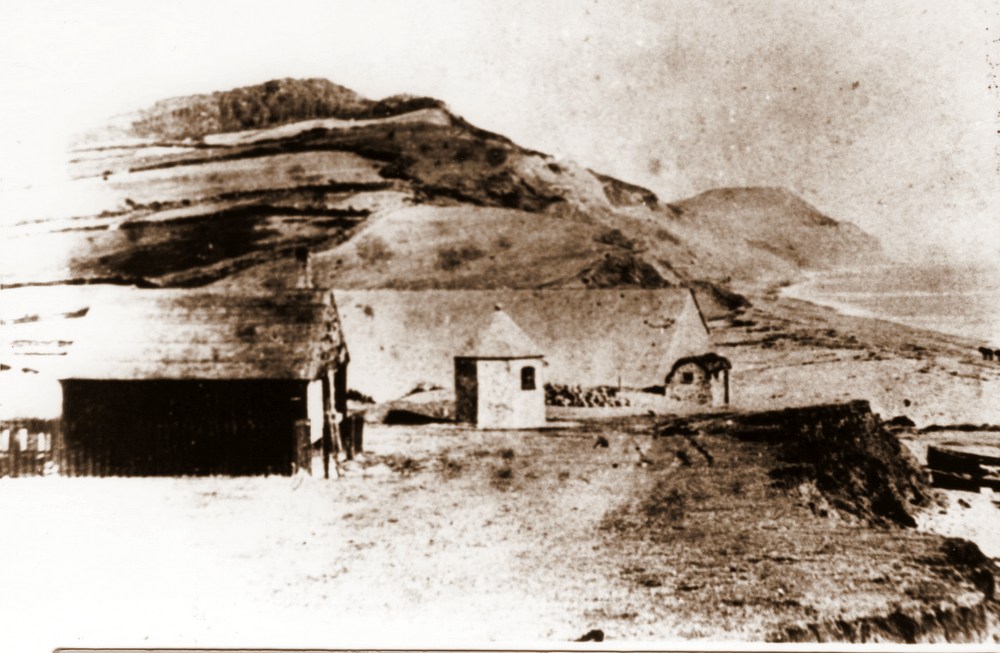
Earliest photograph, believed to be before 1870.
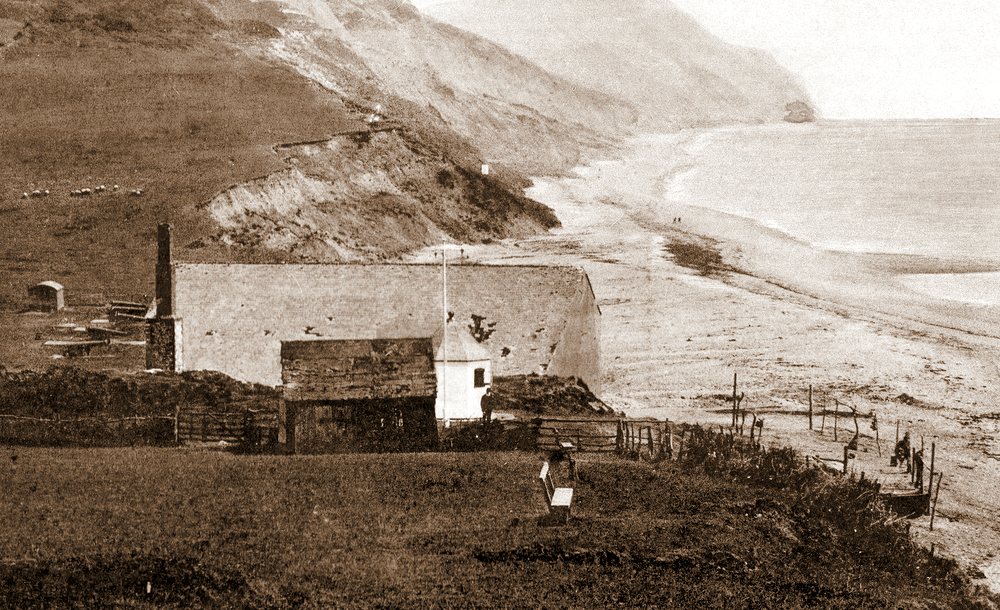
before 1897 as the former Volunteers Battery can be seen on the left in the distance.
The Liddons finally decide to sell The Manor of Charmouth with Langmoor House which together with meadows is almost 100 acres, by Auction at the Auction Mart, Bartholomew lane in London on Thursday 18th August 1853.It is then bought by George Frean, aged 61 and his son George Henderson Frean, who originate from Plymouth for £6500. The family have prospered and George senior is shown as Mayor of the town at one time. They are described as corn merchants and operate a number of mills in the Plymouth neighbourhood and are shown living by Drakes Place Mill in the town. In 1844 George had formed the Plymouth and Dartmoor Gunpowder Company near Postbridge, Dartmoor. Its Production started in 1844 after he had spent £12000 on the venture. The gunpowder was in great demand for both quarrying and for farmers clearing rock from their land. Over a hundred people were employed and it prospered until the invention of dynamite in 1867 when demand fell dramatically. George Frean retired in 1885 after selling this business.
It is difficult to reason why he was to pay such a large sum for the Charmouth Manor Estate, but in the end it proved a good investment. Before the year was out he was to sell off Langmoor Manor from it to Ann Farwell Moly for £3400 and a parcel of fields to John Wilcocks for £2000. His name rarely appears in the records of Charmouth, for at this time the Censuses show him living in Drakes Place in Plymouth with his family. But one interesting piece of information is a 1861 Census showing that his son John Fender Frean between 1856 and 1858 had 3 children one being born in Lyme Regis and the other two in Charmouth.But by the 1861Census he has returned back to Plymouth. He no doubt lived in one of his fathers houses in the village, but it is difficult to pinpoint precisely which one for this short period. Harrods Directory for1855 describes George Frean as the Lord of the Manor and the main land owner. There is another reference to George being paid a rent of £3 a year by the Excise men who occupied the cliff slope immediately west of the Cement Factory. Here they had built the little octagonal lookout, which still stands on the Manor land. The deeds for the Manor of Charmouth show that he borrowed heavily against it's value and by 1863 owed £3750. When it was eventually sold,his son George Hender Frean is shown as benefiting from the sale and it no doubt helped with the finance of his other business. For his claim to fame is that he was one of the co-founder of the world famous biscuit firm - Peek Freans.
It is worthwhile studying the connections with the firm as there is a direct link in the neighbourhood with the other part of the name -Peek. For in 1871 Sir Henry Peek, M.P. For Mid Surrey established his Estate at Rousdon, near Lyme Regis. His father was James Peek who had run a successful Tea Importers in London and in 1857 wished to diversify after his sons refused to join the family business. He decided to set up a new business and contacted George Hender Frean, a miller and ships biscuit maker who had married Hannah Peek, one of his nieces. Peek wrote to him explaining he would set up a biscuit factory for his sons if Frean would manager and partner, he accepted. Sadly it did not work out for the sons , but Peek Freans was to prosper under George Frean. He went on to contact an old school friend, John Carr who had a background in biscuit manufacture and was to develop the famous Pearl biscuit, which was the pioneer of the biscuit we know today. In 1866 they had outgrown their former premises and built a huge factory in Bermondsey which continued to be a major employer in the area until it closed down in 1989. Celebrated lines invented by Peek Freans were: Garibaldi(1861) ,Maria (1875),golden puff,(1909),bourbon(1910).shortcake(1912),cheeselets and Twiglets.
I have pondered over why George Frean attended the Auction in London when the Charmouth Estate came up in 1853. His background shows him as a successful entrepreneur willing to create a business from nothing as he no doubt was able to do with the gunpowder factory he set up on Dartmoor. He obviously was not that interested in Langmoor Manor as a house to live in, as he was soon to sell that it off and then went on to sell part of the farm very quickly to raise money. He used what remained as an asset to borrow against. His main focus must have been the setting up of a Cement Works near the existing Lime Kilns by the mouth of the River Char and the sea. His sister, Anna Frean had married Michael Morcom, described as a merchant at Plymouth in 1836. They were to have ten children. One of whom - George Frean Morcom was to later reside in Los Angles and become world famous as an Ornithologist. But in 1851, the family are living at St Agnes in Cornwall and Michael is described as a Mine Agent. No doubt with a background in quarrying the Morcoms would be ideal for running a Cement Factory for George. By January 7 th , 1863 the building we see today had been finished by the local builders, Pryers and a later auction catalogue reveals that Mr. Morcom of Plymouth had a 21 year lease and was paying £100 a year rent for a Cement Mill, a Stone and Slated Building, with two floors, lean to, and two kilns. On top of the rent there were royalties of 1s 6d per ton on Cement,1s per ton on unmanufactured Stone,1s per ton on Manganese, and 2s per 1000 on all Bricks,Tiles and other like articles manufactured by the Lessee. But sadly the business never took off and may well have contributed to George Freans decision to sell his Estate to John Hawkshaw on January 1 1864 for £6000. This was precisely 10 years from the day he had bought his property in Charmouth from the Liddons. So ended an interesting chapter in Charmouth`s history which few people would be aware of . It does explain why the Cement Works came to be built. In its day, a white elephant due to its size, but now an important resource for the promotion of the Town
from the Cement Industry in Lyme Regis.
The Old Cement Mill, Charmouth From about 1850 John Morcombe & Sons, a Plymouth-based enterprise, set up a works at Charmouth to make cement from the Two Cementstones, a part of the Black Ven Marl (Warren 2005). Cement making, from Devonian Limestone, was an old established Plymouth business and hydraulic cement, for which pure Devonian Limestone is unsuitable, was needed for the construction of the Plymouth Breakwater and the Devonport naval dockyard.
The Cement Mill building still exists as the Heritage Centre, right on the shore at the end of Lower Sea Lane, and can clearly be seen as a large white building from Lyme Regis. Some millstones are preserved on the cliff above the centre. The cementstones occur higher up in the Lower Lias sequence than the Blue Lias, which does not outcrop at Charmouth, but they approximate to the best bed once used for hydraulic cement making at Lyme, the West Rock. The Two Cementstones are the cement-grey flat nodules of muddy limestone which can be seen lying on the upper part of the beach on the Lyme side of Charmouth, where they have fallen from higher up in the cliff, where they occur as bands within the mainly mudstone sequence of the Black Ven Marl.
The cementstones were collected from the beach, the larger ones, known as “roundstones” by horse and cart, and the smaller ones by women in pairs, paid 3d (1.25p) per full basket (40lb or 18kg). The stones were taken to the Cement Mill, where they were broken, crushed and mixed with clay got from the cliff before being burnt and the cement clinker ground to a fine powder by granite millstones, two of which are now form the ends to a seat.
Another Plymouth-based enterprise, Hutchinson & Frean took over the Charmouth mill in 1853 and closing it in 1867. It suffered from having no harbour and, from 1855, the large cement works at Lyme was in the same ownership. Cement had to be loaded into flatbottomed boats from the beach, a hazardous operation in which it would be difficult to keep the cement dry. The chimney was demolished about 1900, the building being used as a fishermen’s store, tea room and store for deck chairs and beach tents. Stone and clay removal resulted in more rapid cliff retreat, causing increased landslipping in the 20th century, which is often wrongly blamed on fossil collectors removing supporting material from the cliffs.
The first Lyme Regis Cement Works Production of cement in Lyme started on a large scale in 1855 when Hutchinson & Frean set up their large cement factory at the back of Monmouth Beach to produce hydraulic cement. The Company had started in a smaller way in the area in 1853, taking over the Charmouth Cement Mill from John Morcombe & Co, as explained above. In that year it leased the stone rights west of Lyme to Devonshire Head from the Henley Estate. The first item to be built was a tramway in 1853, shown on Lt Cox and Master Davis’ 1854 Chart of Lyme, no doubt to aid construction of the works. This ran from the Cobb Landing Quay as far west as possible without crossing the actual beach shingle. It eases the movement of stone, cement and, presumably, the delivery of plant. To start the firm started making the bricks on site to build the works and started shipping stone out (see other papers in this series: No. 5 Stone and No. 7 Pottery & Brick).
The company sold up to 120 tons per week of Blue Lias stone, bricks, cement, lime and char (see above advertisement from Roland Brown’s Beauties of Lyme of 1857). Char is similar to ash, but is collected from the flues rather than ash, which collects below the grate. It contains lime and silicates as well as burnt coal, ash and partly-burned coal and coal clinker drawn through by the up draught. It could not be collected from a pot kiln as it would escape with the smoke, suggesting that a more modern forced-draught kiln was being used, for which there is no other evidence. Equally it could have been collected from the boiler flues of the steam engine. Some chars can be used as fertilizer or soil improver, or mixed with cement, to make breeze blocks, but why these chars were sold and how they were used is not known. In the 1890s tonnages of “breeze” were exported from the Cobb by Haycraft (Harbour Dues book 1884-1903).
In 1867 Messrs Harveys of Plymouth took over the works, although initially the takeover cannot have been smooth, as workers had to be laid off until the lease on the western cliffs had been renegotiated, necessitating a public subscription for the men until the spring of 1868 (Dorset County Chronicle, May 1868).

A photograph taken before 1896 of the river passing near the Cement Works. Its course was altered in 1906 to present postion.
The same view today
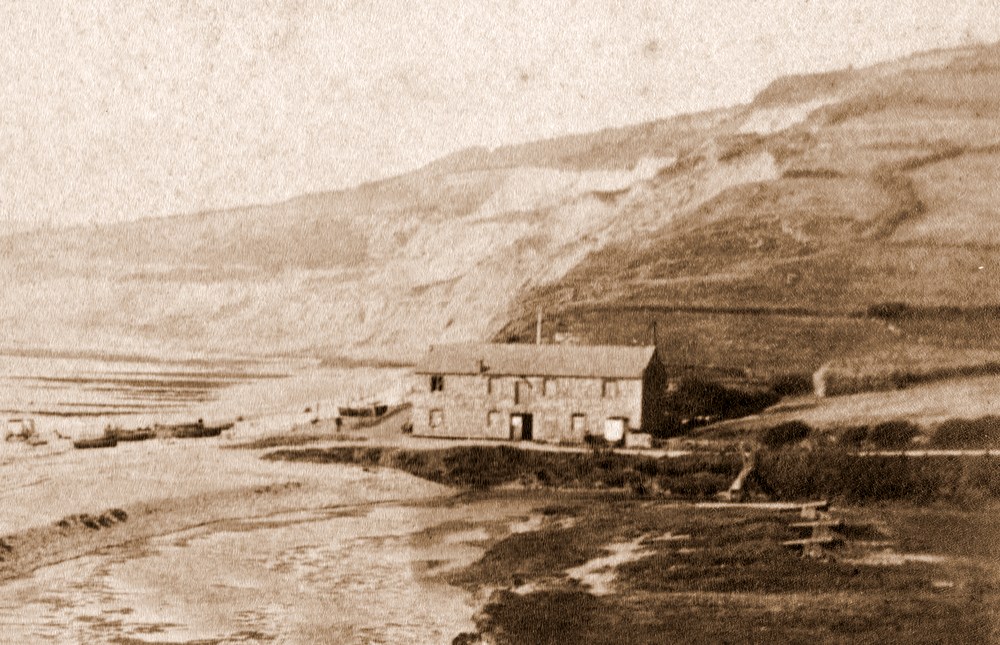
A close up showing Cannons on beach and bathing machines and Luggers on the shoreline.
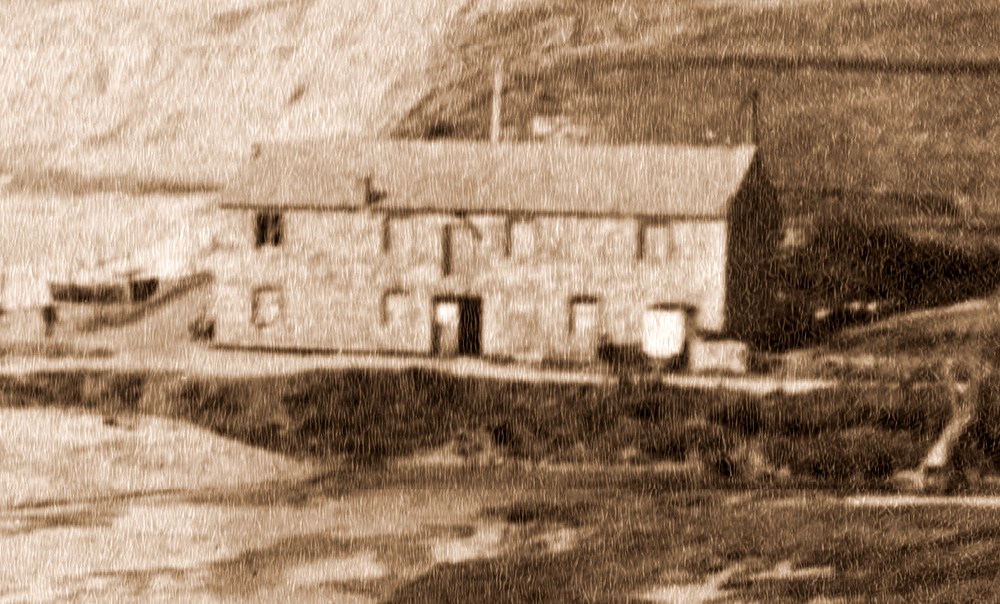
A close up of Cement Works.
.jpg)
The same view today
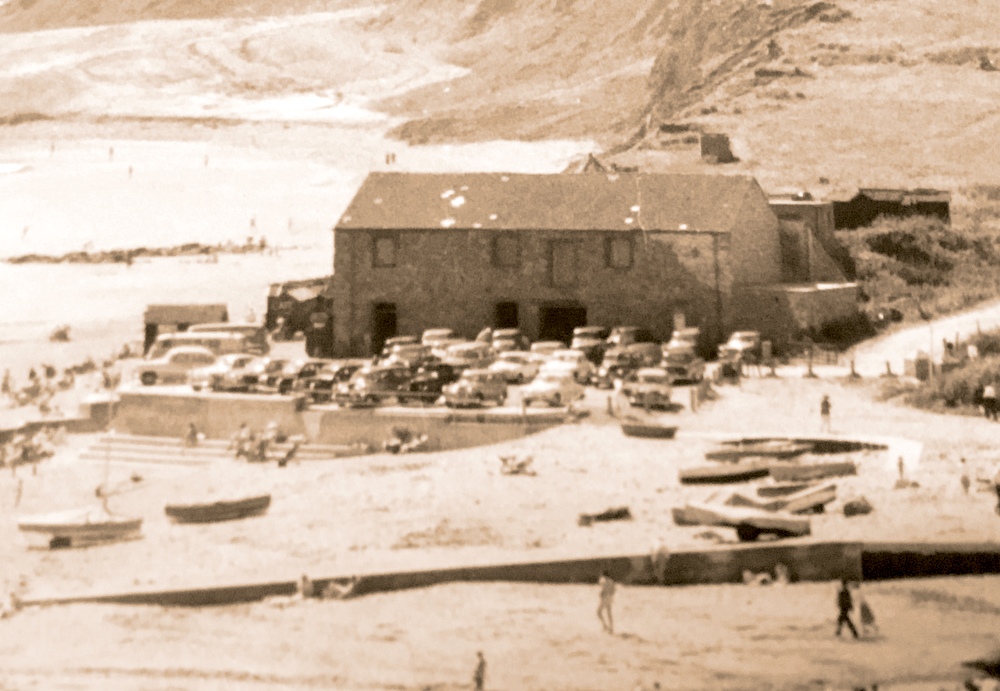

Heritage Centre in the 1970s
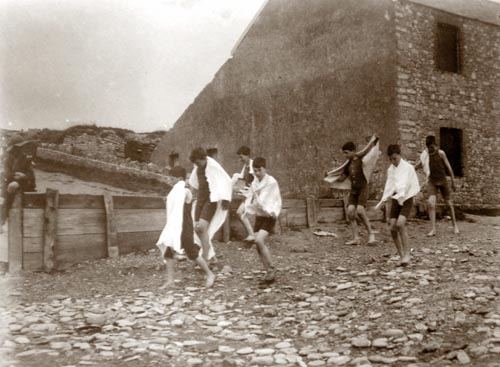
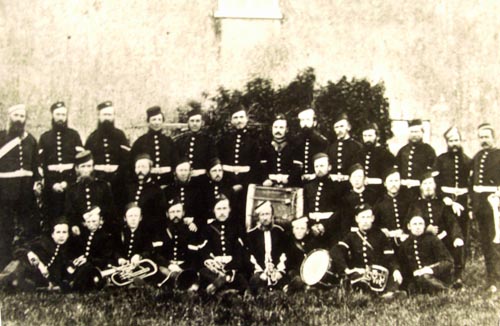
Boy Scouts in 1912
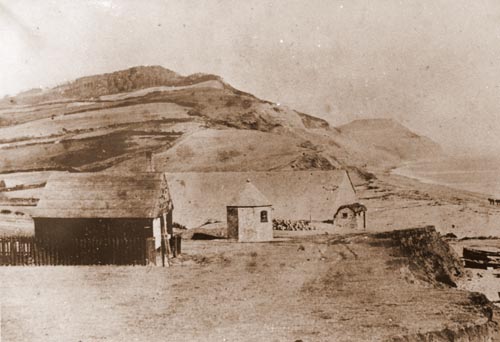
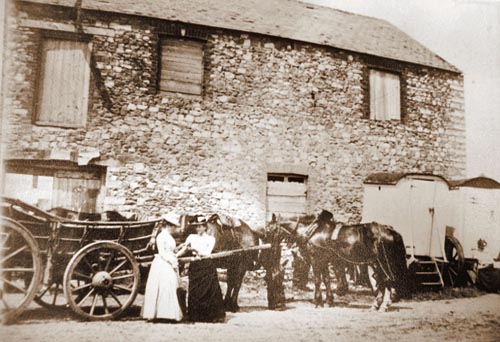
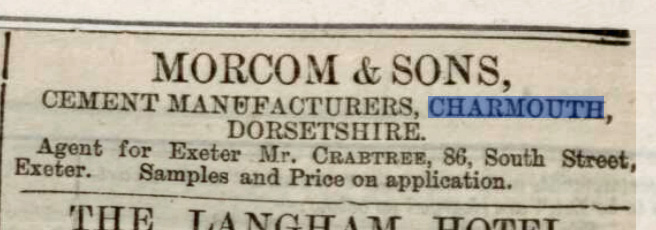
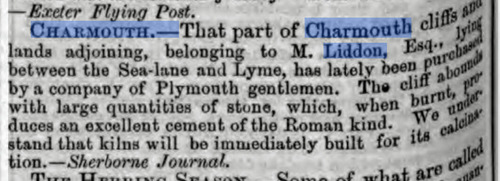
June 1865
October 1853
